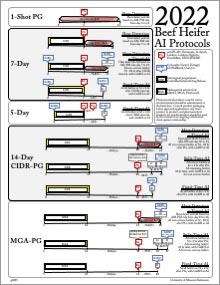
Editor’s note
The protocols described below are illustrated in the PDF, which is available via the “Download this publication” button.
Overview
1-Shot PG: This protocol is simple, consisting only of administration of PG. However, this protocol requires heat detection and will require performing AI over multiple days. Because it does not involve a CIDR, MGA, or GnRH, it has a lower overall pharmaceutical cost. However, this protocol will not be effective among heifers that have not yet reached puberty. Also note that this protocol involves a significant time commitment for heat detection and AI, and heat detection needs to begin 5 days prior to PG. This protocol is an option for producers who are comfortable with heat detection and AI, have plenty of time and labor, and know that heifers are already cycling.
7-Day: The 7-Day CO-Synch + CIDR protocol involves only two animal handlings prior to fixed-time AI, and it offers acceptable results in heifers. Note that the recommended timing of fixed-time AI following the 7-Day CO-Synch + CIDR protocol is earlier for heifers (54 hours after CIDR removal) than cows (66 hours after CIDR removal). This protocol works best among heifers that have already reached puberty. For mixed groups of pubertal and prepubertal heifers, longer presynchronization-based protocols like the 14-d CIDR-PG protocol are preferred. However, the 7-Day CO-Synch + CIDR protocol is a good option if heifers have reached puberty prior to the start of the protocol and scheduling issues will not allow use of long-term protocols.
5-Day: The 5-Day CO-Synch + CIDR protocol is similar to the 7-Day CO-Synch + CIDR but involves a shorter period of CIDR treatment. As a result, it requires administering two doses of PG approximately 8 hours apart. Research suggests a modest improvement in pregnancy rates in comparison to the 7-Day CO-Synch + CIDR protocol. However, because of the additional handling of animals and the additional pharmaceutical cost, this is a less commonly recommended protocol for heifers. Like the 7-Day CO-Synch + CIDR protocol, this protocol works best among heifers that have already reached puberty. For mixed groups of pubertal and prepubertal heifers, longer presynchronization-based protocols like the 14-Day CIDR-PG protocol are recommended.
14-Day CIDR-PG: A very effective protocol commonly used across the United States, this protocol involves treatment with a CIDR for 14 days. A subfertile period of heat activity will occur in the days after CIDR removal, but AI should not be performed at this time. Instead, PG is administered 16 days after CIDR removal, followed by heat detection, split-time AI, or fixed-time AI. This protocol is highly recommended for heifers due to the pregnancy rates obtained in mixed groups of pubertal and prepubertal heifers. In addition, the longer protocol schedule provides an opportunity to perform other tasks at CIDR insertion, such as prebreeding exams and vaccinations. Sexed semen can be used effectively with this protocol with heat detection or split-time AI. If using sexed semen, consider using estrus detection aids to identify heifers that are the best candidates to receive sexed semen.
MGA-PG: This protocol involves inclusion of melengesterol acetate (MGA) in a feed mixture for a period of 14 days. A subfertile period of heat activity will occur in the days after removal of MGA from the feed, but AI should not be performed at this time. Instead, PG is administered 19 days after the last feeding of MGA. This protocol works well with heat detection, split-time AI, or fixed-time AI. Compared to CIDR-based protocols, this protocol requires less handling of animals and is also very cost-effective. However, there are several important factors to consider in designing a feeding program that works well with MGA. These considerations include the acclimation of heifers to eating the feed carrier, the inclusion rate of MGA in the feed (0.5 mg per head per day), the total amount of the feed carrier fed to achieve the required daily dose of MGA, the feeding schedule, and the bunk space allotted to each animal. This protocol is usually recommended only for experienced cattle feeders and for situations in which heifers are already being fed daily during the development program. Note that MGA is not label-approved by the U.S. Food and Drug Administration for use in mature cows, and protocols incorporating MGA should not be adapted for use in cows.
2022 beef heifer AI protocols
Pharmaceutical products used for estrus synchronization should be administered at the label dose. Consult product packaging. Label-approved applications vary from product to product, and pharmaceutical products for synchronization should be used in the context of an ongoing veterinarian-client-patient relationship.